Source: NZLPP Secondee database
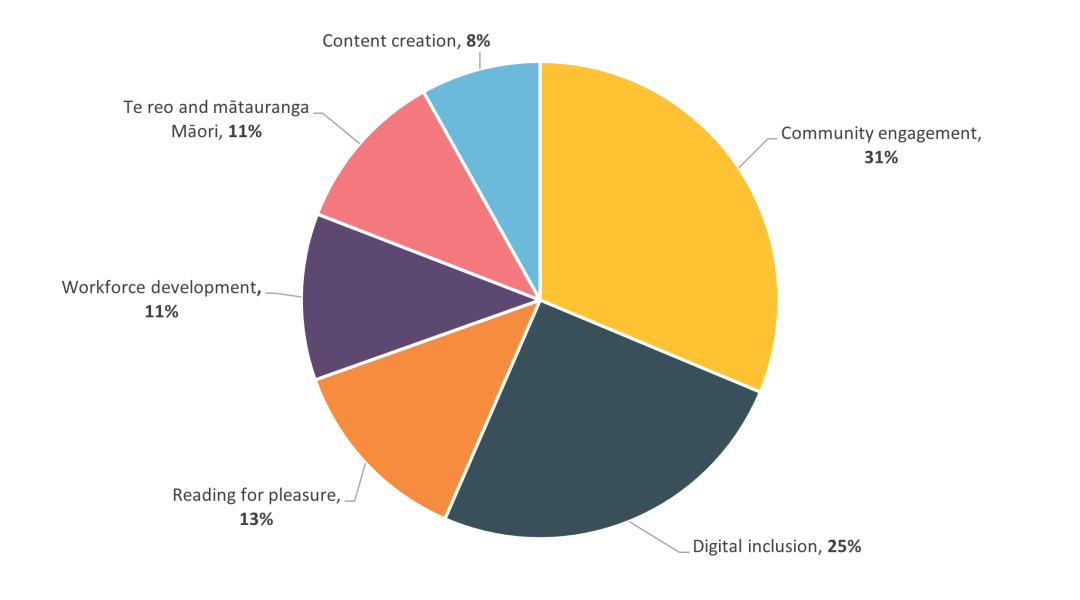
Source: NZLPP Secondee database
This report is an evaluation of the short-term outcomes of the New Zealand Libraries Partnership Programme (NZLPP) and its benefits to library users, communities, and the library workforce.
This is the web version of the Evaluation of the New Zealand Libraries Partnership Programme.
You can also download the PDF version Evaluation of the New Zealand Libraries Partnership Programme (pdf, 3.8MB)
This report has been prepared for Te Puna Mātauranga o Aotearoa | National Library of New Zealand by Matthew Fanselow, Megan Prentice, Chelsea Steen-Jones, and Donella Bellett from MartinJenkins (Martin, Jenkins & Associates Limited).
For 30 years MartinJenkins has been a trusted adviser to clients in the government, private, and non-profit sectors in Aotearoa New Zealand and internationally. Our services include organisational performance, employment relations, financial and economic analysis, economic development, research and evaluation, data analytics, and public policy and regulatory systems.
We are recognised as experts in the business of government. We have worked for a wide range of public-sector organisations from both central and local government, and we also advise business and non-profit clients on engaging with government.
Kei te āwhina mātau ki te whakapai ake i a Aotearoa. We are a values-based organisation, driven by a clear purpose of helping make Aotearoa New Zealand a better place.
Established in 1993, we are a privately owned New Zealand limited liability company, with offices in Wellington and Auckland. Our firm is governed by a Board made up of executive directors Kevin Jenkins, Michael Mills, Nick Davis, Allana Coulon, Richard Tait, and Sarah Baddeley, as well as independent director Sophia Gunn and chair David Prentice.
In January 2022, Te Puna Mātauranga o Aotearoa | National Library of New Zealand asked MartinJenkins to evaluate the short-term outcomes of the New Zealand Libraries Partnership Programme (NZLPP), to help it understand the NZLPP’s impact on the library sector and communities across Aotearoa.
We interviewed key stakeholders, surveyed library managers and secondees, and visited three libraries.
Our evaluation focused on the programme’s three main initiatives:
Secondee Project – secondments at public libraries to upskill the library workforce, and bolster reading activity and digital literacy for children, young people, and adults
Fee Waivers – financial relief for libraries through the waiving of user charges and procurement costs for collaborative library services
Free Public Internet – free internet access at all public libraries, ensuring that all library users have access to online services.
The library sector found the Secondee Project to be of the most benefit to their libraries. As well as providing a valuable “extra pair of hands”, the secondees brought new and diverse skills and expertise into the library sector. This new resource allowed libraries to develop and implement new initiatives and programmes that were beneficial and highly valued by their users.
The different initiatives by libraries that were part of the NZLPP were categorised under six “focus areas”: digital inclusion, workforce development, community engagement, reading for pleasure, te reo and mātauranga Māori, and content creation. The NZLPP has provided considerable benefit to library users and communities nationwide in each of these six areas – this has included increased digital literacy and confidence, increased community engagement with library facilities and services, and increased skills and expertise in the library workforce. The impact of the NZLPP is further detailed in three case studies, included in this report.
Significant benefits of the NZLPP for the library workforce included exposing staff to the new skills and experience brought by the secondees, and increasing the diversity of the workforce.
The Programme ended on 30 June 2022, and the library sector is concerned that the benefits produced through the NZLPP will not be sustainable in the long term.
Many of the benefits to communities and staff have been made possible through increased funding (the Fee Waivers) and increased staffing (the Secondee Project), and without that increased support many in the sector believe it won’t be possible to sustain the achievements and progress made.
Encouragingly, however, more than half (60%) of the library managers we heard from said they would be able to retain secondees beyond the end of the NZLPP. Many were able to use the success of the Programme to convince their council to let them retain the additional staff, in a mixture of full-time, part-time, and temporary roles, or to recruit to fill the secondee’s role if the secondee did not stay on at the library.
Libraries are a core community resource. They serve as community hubs where people know they can access help and support, access information, and make social connections. Libraries are playing an increasingly important role in helping to bridge the digital divide in New Zealand, facilitating access to online resources and digital training courses.
“Libraries are the only social contact for some people – we might be the only people they talk to in a week” – Library manager, Taranaki
The outbreak of COVID-19 in New Zealand caused much stress and uncertainty for library staff. Library managers feared having to close their doors – which would have had significant adverse impacts for both the staff, and the communities they serve who rely on libraries to access many of the resources and supports they need.
“Uncertainty and stress were both very high for us, both among the community and our staff” – Library manager, Marlborough
The key concern for library managers was the risk of having to lay off staff, with many anticipating that their Councils would look to reduce or redirect library funding to other areas. This would have had a significant impact on their ability to deliver core services, and would have put considerable pressure on the ability of libraries to deliver the discretionary services that many in the community rely on, such as training programmes.
“There is always political pressure to monitor spending – we were expecting to be told to make cuts” – Library manager, Taranaki
In 2020, Te Puna Mātauranga o Aotearoa received $58.8 million from the Government to lead and support COVID-19 recovery work across New Zealand’s public library system. The New Zealand Libraries Partnership Programme (NZLPP) was a two-year programme to help libraries retain staff and services, and to help them support their communities to recover.
“Libraries play a vital role as a community hub, and they can be places where people can get real, practical help during the tough economic times. This new money, and the range of initiatives, recognise the role that libraries play, and that Councils are going to be facing funding pressures. It’s a much-needed boost to keep these services going and support the New Zealand public though the recovery”
– Hon Tracey Martin, Minister of Internal Affairs (May 2020)
A core part of the NZLPP was the Secondee Project, the aim of which was to expose non-library staff to the library sector, and to provide professional development and upskilling for the library workforce. More than 200 secondees took part. They brought a diverse range of experience and technical skill to the library sector, including Māori liaison and engagement, archiving, digital learning, community engagement and outreach, learning and discovery, and youth engagement.
The NZLPP provided financial relief for libraries in the form of fee waivers for user charges, fees for the Aotearoa People’s Network Kaharoa (APNK) (1) service, and procurement costs for library services. Libraries were free to use the savings from the fee waivers for any library expense.
The third key initiative was free public internet. Libraries were supported to offer free internet to their communities through network fee waivers and other financial supports, to ensure that everyone was able to access online services.
The NZLPP funding was also used to support:
Strategic Partnership Grants: grants to library-sector organisations to build on the support already by the NZLPP to the wider library sector, in a strategic and sustainable way
Library Sector Sustainability (2): initiatives to ensure that the two-year NZLPP will have long-term impacts for the sector, to ensure libraries can continue to support their communities to thrive.
Te Puna Mātauranga consulted early on with libraries and communities and identified six “focus areas” to form part of the foundation of the Library Partnerships Programme. In signing up to the NZLPP, each library selected one or more focus areas where they thought support from the NZLPP would make the biggest difference for their communities.
The six focus areas were:
Digital inclusion, supporting and assisting job seekers and learners – including digital literacy for seniors, children and young people
Library workforce development, supporting an increasingly diverse workforce – including retention and development of Māori and Pasifika staff, leadership development, trainee recruitment and career progression development
Community engagement, supporting community recovery – including capability building, co-design skills, programming and outreach and by targeting non-users
Reading for pleasure, supporting wellbeing – including local programme, partnerships and support for young people, whānau and communities
Te reo and mātauranga Māori, supporting local iwi – including skills development
Content creation and curation of online NZ resources –with a focus on local resources.
When the NZLPP began, libraries were asked to produce “action statements” to describe the activities or initiatives they intended. Each action statement had to be linked to one or more of the Programme’s focus areas. A total of 244 action statements were submitted.
The following pie chart shows what proportion of action statements were submitted under each focus area. It shows that, in particular, many of the libraries saw community engagement and digital inclusion as very important and relevant for their users and communities.
Figure 1: Proportion of NZLPP action statements aligned with each focus area
Source: NZLPP Secondee database

Source: NZLPP Secondee database
Pie chart showing what proportion of action statements were submitted under each focus area.
8% — Content creation
11% — Te reo and mātaurange Māori
11% — Workforce development
13% — Reading for pleasure
25% — Digital inclusion
31% — Community engagement
The NZLPP was designed to help libraries achieve a range of outcomes for their communities. These included a wider range of services to meet local community needs, increased skills in the library workforce, increased community access to digital services, and increased engagement between libraries and their communities.
Over the last two years the NZLPP has contributed significantly to libraries, achieving a broad range of benefits for both the library workforce and the communities that use the libraries. Libraries have delivered benefits ranging from improving digital literacy and confidence, to displaying and normalising te reo Māori, to digitising valuable historical records. Across Aotearoa New Zealand the NZLPP has made a clear, positive contribution to the library sector.
Library managers and secondees were asked to rank the three initiatives (Secondee Project, Free Public Internet, and Fee Waivers) in order of how much benefit they were to their library. The vast majority of respondents (89%, n=97) ranked the Secondee Project as the most beneficial.
Both library managers and secondees ranked the Secondee Project as the most beneficial. However, those two groups ranked the other initiatives differently (Figure 2). 12% (n=8) of secondees ranked the Free Public Internet initiative as the most beneficial to their library; no library managers rated it as the most beneficial. 7% (n=3) of library managers ranked the Fee Waiver as being of the most benefit to their library, compared with 1% (n=1) of secondees.
These differences likely result from the different areas each group is exposed to. Secondees saw the Free Public Internet initiative as being beneficial because they spent most of their time engaging with the public and heard about the benefits of free internet access. The library managers, unlike most secondees, understood the details of the fee waivers and the benefits these provided to their libraries.
Figure 2: Ranking of which initiative was of most benefit to libraries
Source: Library Manager (n=42) and Secondee (n=67) evaluation surveys
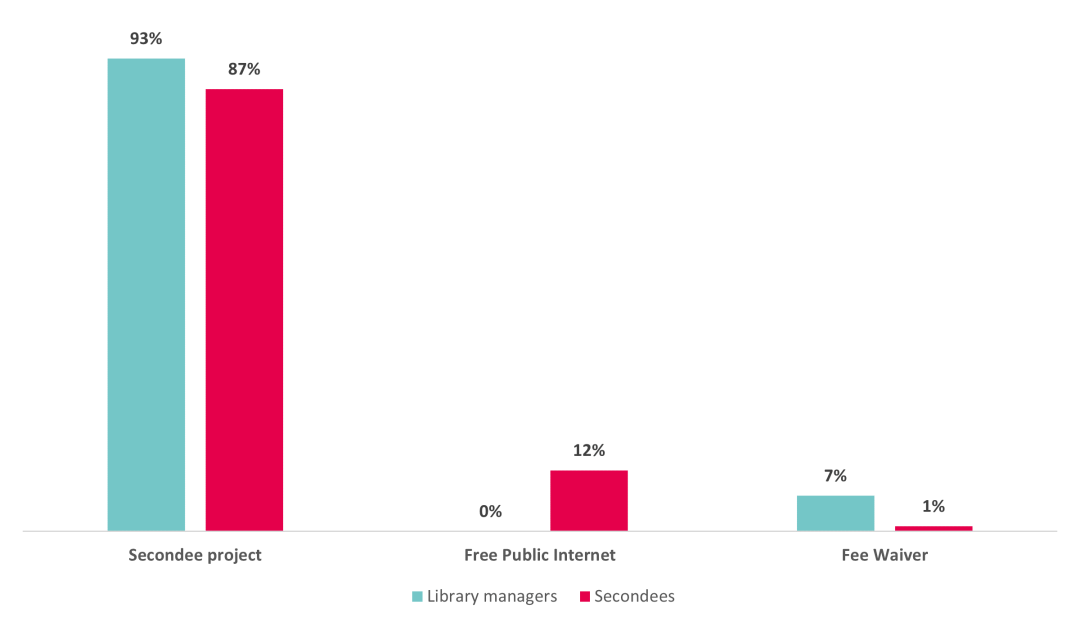
Source: Library Manager (n=42) and Secondee (n=67) evaluation surveys
Bar graph showing library managers' and secondees' responses as to which of the three initiatives (Secondee Project, Free Public Internet, and Fee Waivers) were the most beneficial to their library.
93% — Library managers
87% — Secondees
0% — Library managers
12% — Secondees
7% — Library managers
1% — Secondees
A key benefit of the Secondee Project has simply been having an “extra pair of hands”. The benefit of this extra capacity has been varied – from helping to deliver library projects that had long been planned but that had lacked the resources, to developing new and specialised programmes and service offerings.
As a result, library services have grown. The secondees have enabled libraries to engage with areas of their communities that have previously been out of reach, or disinclined to engage with library services.
“The Programme has let us do things that we have had planned for 10 years but never had the capacity to deliver” – Library manager, Hawke’s Bay
Library managers were asked whether they were able to take full advantage of the Secondee Project and take on as many secondees as they would have liked. More than three-quarters (78%,n=31) of library managers reported that they were able to take on the maximum number of secondees.
13% (n=5) of library managers stated that they were unable to take full advantage. This was due to a combination of:
challenging council recruitment processes
lack of staff time to manage secondees
difficulty in attracting suitable candidates.
Library managers were also asked about the costs related to their secondees. 95% (n=38) of library managers reported that the costs for the Secondee Project were fully covered by the NZLPP.
“The biggest thing for us were the secondees. To be able to have two new full-time staff was just brilliant” – Library manager, West Coast
“Having dedicated staff to deliver on key community impact areas was the best thing about the Secondee Project”
We asked library managers and secondees to give feedback on what they thought were the best aspects of the Secondee Project. We got feedback from 60 managers and secondees, and they gave a range of perspectives, summarised below.
Through the NZLPP and the secondees, libraries have been able to dedicate time and resources to develop new programmes to meet the needs of their local communities. Many stakeholders shared that, through the Programme, their libraries have been able to undertake new initiatives and areas of work that would not have been possible without the funding and support from NZLPP.
Libraries have been able to increase their services and reach into their communities, providing a wider range of support and programmes in areas including digital upskilling, engaging with Māori and Pasifika, youth-centric programmes, and promoting reading for fun.
The ability for libraries to digitise an extensive range of materials – from books to local histories and historical documents – was emphasised as a particular benefit for local communities and for the library sector as a whole.
“[NZLPP] gave us the opportunity to bring people in to do the things that our library has aspired to do, but lacked the resourcing” – Library manager, Waikato
We heard that one of the key benefits of the Secondee Project has been that it made libraries and their services more visible, increasing awareness of them in the community and enhancing their reputation.
The increased support the secondees provided has made a difference in a range of ways. As well as providing more staff resources for day-to-day library services, secondees helped libraries to promote and foster digital literacy and inclusion, to promote reading for pleasure, and to do more to incorporate te reo and mātauranga Māori into the library. This has resulted in libraries realising a higher level of their potential.
Communities are now much more aware of, and engaged with, the resources and services offered by libraries.
“We were able to revolutionise our library service, turning it from a nearly totally resource-based service to one that has much greater engagement with the community”
– Library manager, Canterbury
We also asked library managers and secondees whether the Secondee Project could be improved in any way. Our findings below have been drawn from feedback from 37 stakeholders.
The concern we heard most often was that delays at the inception of the NZLPP resulted in libraries being unable to take advantage of the full two years of the Secondee Project. This was mainly because of council recruitment processes taking a long time after NZLPP funding had been approved.
The stakeholders would like to have seen more lead-in time at the beginning of the Programme, or alternatively an extension of the Programme, to account for the lost time.
“By the time the funding was approved, and we dealt with the advertising and employment issues, it was 6 months before secondees started in their roles”
– Library manager, Bay of Plenty
Stakeholders also raised several other potential areas of improvement, but these comments were less frequent. These were:
the need for more guidance and suggestions from the NZLPP team on ideas for projects that the secondees could work on
less of an administrative burden for library managers (for example, invoicing and reporting)
allowing all staff to participate in the training modules and learning management system, not just the secondees
greater information sharing about what other libraries were doing with their funding
support structures to help library managers handle the increased management workload.
The majority of public libraries in New Zealand are funded by their local councils. The NZLPP fee waivers were intended to be used for library services, but there was a risk of councils reallocating the funding to other areas.
Library managers were asked whether they were able to use all of the savings from the fee waivers, or whether the funding was repurposed by their council. Most library managers (85%, n=46) reported that the funding was able to be fully used by library services. The remaining 15% (n=8) reported that the council reallocated a small portion of the fee waiver savings, with most of them being used to fund library services.
The Fee Waiver initiative provided the library sector with a considerable cash injection. Except for the small portion that councils used for non-library purposes, the funding was used by libraries across a diverse range of activities and projects, as described below. These findings have been drawn from feedback from 65 stakeholders.
Libraries were able to use the additional funding to invest in new equipment and technology. This included buying virtual reality headsets; trolleys and storage equipment; laptops and tablets; and STEM (science, technology, engineering, and math) learning kits.
“We were able to buy additional equipment across all of our branches, so that we could continue to provide services during both lockdowns and levels red and orange”
– Library manager, Taranaki
Many libraries took the opportunity to increase their range of databases and online subscriptions. This was of immense benefit to libraries, enabling them to expand their e-resources and to trial new services that would otherwise have been too expensive to provide. The increase in e-books, and access to Press Reader, were of particular benefit to library users when libraries couldn’t be accessed in-person during COVID-19 lockdowns and higher alert levels.
“The waivers enabled us to put more budget into subscriptions of additional online platforms, to increase our digital outreach and language resources for our diverse community. Very timely, given the COVID effects and the community staying away from public spaces” – Library manager, Otago
Libraries also used the extra to invest in their staff. This included offering training programmes to increase their library management and operation skills, and digital training and upskilling. Libraries were also able to offer classes to their staff in te reo Māori and tikanga. Some libraries used the funding to increase their staffing hours and to recruit additional staff.
“We used the funding to trial new Library Assistant roles. This was so successful, and we have now made those roles permanent” – Library manager, Wellington
Overall, the key benefit of the Fee Waiver initiative for libraries was financial security and lessened budget pressures. This helped ensure that libraries did not have to cut services or reduce staffing numbers, and could continue to offer support and services to communities across Aotearoa New Zealand.
“We did a complete strategic review, looking at the next 10 years. We could never have afforded to do that without the waivers, and the Council was really impressed with it. That gives us 10 years of a plan, not just something that lasts a couple of months, so it’s a big win” – Library manager, Northland
Library managers were asked whether there was anything that could have been changed to improve the Fee Waiver initiative. More than half (59%,n=24) of respondents said they would not have changed anything about the initiative. Of the other respondents, most commented on the nature of the library funding system in general, asking that it be reviewed and the level of funding for public libraries be increased. A small number of stakeholders reported that they chose not to use the fee waivers to invest in new services or subscriptions, as these would have increased the longer-term costs for libraries after the NZLPP ended.
Access to free internet helps to reduce inequality and remove barriers to accessing information and services. The Free Public Internet initiative was intended to ensure that people in communities across Aotearoa New Zealand have access to the internet, for free, and regardless of owning their own device.
The Free Public Internet initiative supported libraries in these specific ways:
it waived subscription fees for the use of the Aotearoa People’s Network Kaharoa
it supported other libraries with their existing free internet service
it supported libraries not currently engaged to join the APNK service at no charge.
The majority (79%,n=33) of library managers reported that their libraries were members of the APNK before the NZLPP. These libraries benefited from the waiving of the APNK membership fees, and were able to reallocate this money to other library services.
Five libraries that were not previously APNK members have since applied to join the APNK through the support of the NZLPP.
“They have gained a love of books – I can see the difference in them”
Whakatāne Library sought to create and deliver a reading for pleasure programme that could be delivered to rural schools. The programme was aimed at encouraging reading and increasing students’ engagement with the library.
“When it started, she [the secondee] would come to our class once a fortnight” said one of the kaiako at the school. “She would model good reading and run activities with the kids. It has been amazing”.
The Read for Plenty Programme has been of significant benefit to the children, helping them to build their confidence in reading. “We have always read every day. I would read to the students, but now they want to take turns and do the Teacher Read to the class. Even those that struggle to read, they give it a go. And the class is really patient with them”.
As a lower-decile school, the classroom has a shortage of good storybooks. The secondee would visit the class once a fortnight, and the following fortnight the class would visit the library. “The visits have really helped the kids to get confident in using the library. Now they know how to find books, how to ask the librarian for help, and how to issue their own books. They have gotten so confident in using the library and talking to the staff”.
With the NZLPP coming to an end, the kaiako is sad at the prospect of Read for Plenty not continuing. “This programme is way better than anything we have had before. We are a very low decile school. Most of the kids don’t have good homes, but even if they do their parents won’t take them to the library. They only go if we take them. We will definitely keep utilising the library if we can”.
“It’s amazing what they can do. My kids are some of the hardest in New Zealand. For them to sit and read for an hour, and be fully engaged, is amazing”
Through the NZLPP the small library in Murupara, Bay of Plenty, was able to recruit a Māori Language and Knowledge Expert as a secondee. Her work was focused on te reo and mātauranga Māori and raising the profile of the library.
“Having her [the secondee] here has really opened the doors to tangata whenua – we never really came to the library before” said one patron. “She even started running waiata classes at the library. When we ran them at the pā, not many came, but here is a neutral ground so everyone feels free to come, because it is noa. We have big groups come along and join in – multigenerational – even people who don’t come to the marae”.
“Her mahi has opened up the library. She brings people in and makes a connection. She’s really raised the profile of the library,” said another patron. “She’s also brought that youth perspective and her digital knowledge. She is a real asset”. The library run holiday programmes for school children, and host storytellers to read to both children and senior citizens. “She is always coming up with ideas. She booked our group [of kuia] a bus to go to Whakatāne and watch Whina. We even went for lunch afterwards. It was such a great day for us”.
“We get overlooked because we are small and rural, with lots of social challenges. The library really brings people together”
One of the main groups that uses the library space is the Māori Women’s Welfare League. The group use the library meeting room for their monthly meetings, where they socialise and learn waiata.
The group, with the support of the NZLPP secondee, has formed a ukulele performance group. “It started off with someone from the school coming along to the library to teach us. She [the secondee] offered us the library twice a week to practice. It is a great social connection for us, too”. The group feel “privileged” to be able to use the library for their ukulele and waiata practice, and have proven to be quite successful players. “It’s turned out that we’re quite popular as a group! We have been requested to play at a lot of events – we have Matariki coming up, and we play at the school. We even have to turn down some requests to play because we’re busy”.
While the support of the NZLPP has been very beneficial, some patrons are concerned about the longer-term outlook for the library. “We are very lucky to have the library. And she could do even more with more support. I really hope that we can keep her”.
“She [the secondee] is the greatest asset of the library. She goes above and beyond, and really embraces the people”
Figure 3: Māori Women’s Welfare League ukulele group performing at Murupara Library
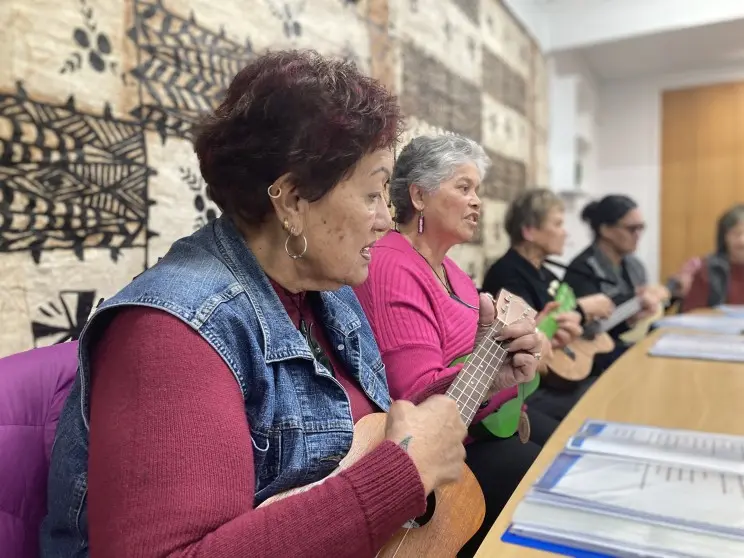
Source: MartinJenkins evaluation team
The NZLPP was of considerable benefit to the communities served by libraries.
Stakeholders were asked to rate the level of benefit they felt the NZLPP had provided to library users (with ‘1’ being very little or no benefit, and ‘5’ being a lot of benefit). As shown in Figure 4, 88% (n=96)of survey respondents thought that the Programme was of some or a lot of benefit to library users and the community.
Figure 4: Benefit of the NZLPP to library users
Source: Library Manager (n=42) and Secondee (n=67) evaluation surveys

Source: Library Manager (n=42) and Secondee (n=67) evaluation surveys
Stacked bar graph showing stakeholders' responses when asked to rate the level of benefit they felt the NZLPP had provided to library users.
2% — No / not much benefit
7% — Neutral
88% — Some / a lot of benefit
3% — I don't know
The NZLPP has contributed considerably to positive outcomes across the library sector and across Aotearoa New Zealand over the past two years.
This section of the report details the outcomes and benefits that have been achieved through the NZLPP, categorised under each of the Programme’s focus areas.
The figure below shows the contribution made by the NZLPP to the library sector. Survey respondents were asked to indicate the proportion of their programmes, activities, and initiatives that their library would have been able to deliver over the past two years without the support of the NZLPP. Nearly three-quarters of respondents (72%, n=78) said they would have only been able to complete half or less of their projects without the NZLPP.
Figure 5: Proportion of projects able to be completed without the NZLPP
Source: Library Manager (n=42) and Secondee (n=67) evaluation surveys

Source: Library Manager (n=42) and Secondee (n=67) evaluation surveys
Bar graph showing survey respondents' responses as to the proportion of programmes, activities, and initiatives that their library would have been able to deliver over the past two years without the support of the NZLPP.
16% — Less than 10% of projects
55% — Between 10% and 50% of projects
28% — Between 60% and 90% of projects
1% — 100% of projects
31% of library action statements focused on community engagement. The community engagement focus area was aimed at “capability building, co-design skills, programming and outreach and targeting non-users”
“There has been a much greater sense of belonging of our community in the projects we are delivering” – Secondee, Tasman
Overall, the feedback from the sector has highlighted that libraries have been able to greatly increase their engagement activities with the community. This has been enabled through increased funding, increased staffing levels, and a greater diversity of skills and experience brought to the sector by the secondees. 89% (n=97) of survey respondents agreed that they have been able to do more to directly engage with their community, with only 4% (n=4) of respondents disagreeing.
Stakeholders gave examples of increased engagement, including:
greater use of social media to promote the library
running new school holiday programmes
increased marketing and promotional work, including updates to library branding
introducing Community Librarian roles, to increase engagement with local groups (such as wānanga, schools, kura, childcare services, and rest homes)
membership drives at schools and community events to attract new and younger users to the library.
Figure 6: Community engagement outcomes achieved through the NZLPP
Source: Library Manager (n=42) and Secondee (n=67) evaluation surveys
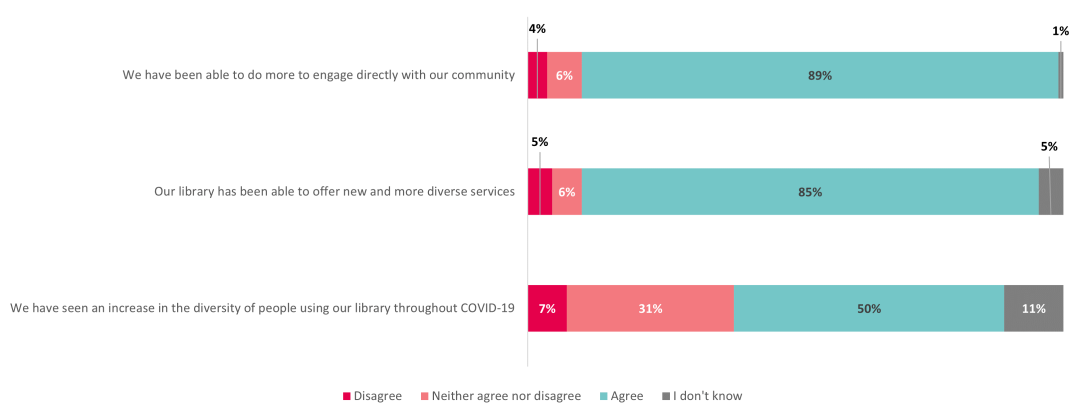
Source: Library Manager (n=42) and Secondee (n=67) evaluation surveys
Stacked bar graph showing survey respondents' responses as to whether they agree with the following statements:
4% — Disagree
6% — Neither agree nor disagree
89% — Agree
1% — I don't know
5% — Disagree
6% — Neither agree nor disagree
85% — Agree
5% — I don't know
7% — Disagree
31% — Neither agree nor disagree
50% — Agree
11% — I don't know
The NZLPP provided libraries with the resources to expand their existing service offerings, and to invest in new services and initiatives. 85% (n=93) of survey respondents agree that, through the NZLPP, they had been able offer new and more diverse services.
Many stakeholders shared that, thanks to the Programme, they had been able to take the time to ‘step back’ and reflect on what they were currently offering, whether this met the needs of their community, and identify areas in which they could offer different services and support.
Examples of new and increased service offerings are listed under the other focus areas in this section.
“The NZLPP has enabled us to build a solid foundation that will support vastly improved levels of service into the future – all with a focus on community wellbeing”
– Library manager, Otago
One of the outcomes of the NZLPP was to see a more diverse range of people using libraries and their services. Survey respondents had mixed views on whether progress has been made towards this outcome, with 50% (n=55) agreeing that there had been an increase in the diversity of users throughout COVID-19. 42% (n=46)of respondents were either unsure or did not know if there had been any increase.
However, feedback from the wider sector highlights that libraries have been increasing their efforts to engage with a diverse range of communities, including vulnerable and marginalised groups. Examples of this increased engagement include:
working with intellectual disability groups to run reading programmes and Lego workshops
job support for the unemployed – helping to prepare CVs and cover letters
active engagement with Māori and Pasifika families with young children
running Pride Week events
offering English language and reading classes for those with little or no English
holding LGBTQ reading sessions and social events
targeted engagement with Māori and iwi groups
“The library is such an interesting place in society. It is a space with no obligation to engage – if you go to a shop, you have to buy something – but at a library you can just ‘be’”
– Secondee, Canterbury
Digital inclusion was a key focus of the NZLPP, accounting for 25% of library’s action statements. The lockdowns and isolations caused by COVID-19 put considerable stress on many people who were not digitally literate, or who were unable to access the internet at home. Libraries were in a unique position to offer technology training and support services to the public, once they were able to reopen.
“Everyone went from ‘you can go out and do anything’ to ‘if you don’t have wifi or can’t use a computer, you are in real trouble’” – Library manager, Waikato
Through the NZLPP, libraries have been supported to deliver an increased number of services and resources digitally. This has been enabled through increased staffing, and increased funding to invest in digital services such as Press Reader. Overall, 86% (n=94) of respondents agreed that their library had been able to offer more services online, with only 4% (n=4) disagreeing.
Figure 7: Digital inclusion outcomes achieved through the NZLPP
Source: Library Manager (n=42) and Secondee (n=67) evaluation surveys
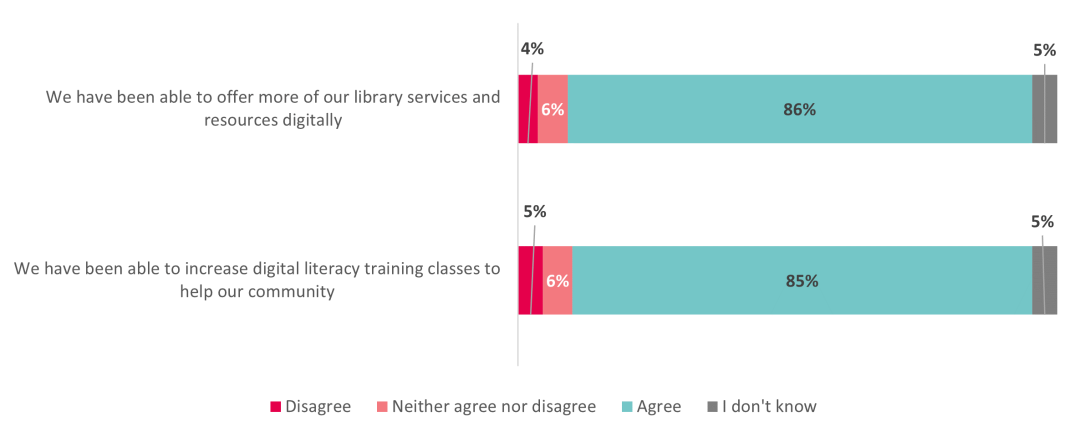
Source: Library Manager (n=42) and Secondee (n=67) evaluation surveys
Stacked bar graph showing survey respondents' responses as to whether they agree with the following statements:
4% — Disagree
6% — Neither agree nor disagree
86% — Agree
5% — I don't know
5% — Disagree
6% — Neither agree nor disagree
85% — Agree
5% — I don't know
“More and more people are going to fall on the wrong side of the digital divide. Libraries are going to be even more important in helping people to access services”
– Secondee, Marlborough
A key focus of the NZLPP was digital inclusion and upskilling, with many libraries taking on secondees to design and deliver programmes and classes to help people increase their digital literacy. 85% (n=93) of survey respondents agreed that their library had been successful in increasing the number of digital literacy classes and training services that they offered.
“Wānanga students come in not knowing how to use a certain template, or how to upload a video for an assignment. One student told us she was going to drop out of the course because she was so overwhelmed by the digital component. So our staff sat down with her and others, and helped them until they were away doing it themselves”
– Library manager, Wellington
Stakeholders from across the country have shared examples of what they have been able to achieve in the digital inclusion space, through the NZLPP. These include:
liaising with other local organisations offering similar support services, to try and avoid duplicating services
remote virtual training classes to help users learn to work their devices, without coming to a public space
purchasing new technology and devices for use at the library, such as virtual reality headsets, 3D printers, and laptops
running regular in-person group training sessions to improve digital confidence
providing Skinny Jump modems to families in need
offering one-on-one “device advice” drop-in sessions, to answer user questions about their devices
13% of action statements related to reading for pleasure. While libraries are primarily thought of as a resource for books and written resources, this has been changing over time as libraries have come to offer a more diverse and extensive range of services – from digital classes to cultural events to school holiday programmes. And while the increased range of services is key to attracting new users to the library, lending services remain the core business of libraries.
“We’ve seen libraries get rid of a huge portion of their book stock to make room for 3D printers. But the only people that can buy and lend books, and help with literacy, are libraries. Maintaining that core business is so important, and there are real risks if we don’t” – Library manager, Taranaki
The restrictions to meeting in-person, as a result of COVID-19, have made it difficult for libraries to host reading programmes. This has been due to a combination of gathering restrictions, users being uncomfortable being back in public spaces, and the uncertainty surrounding alert level changes meaning libraries have been unwilling to invest in new programmes that may end up being cancelled.
Overall, 52% (n=57)of survey respondents agreed that their library had been able to run more sessions that encouraged reading for fun. Some libraries have successfully trialled online resources to promote reading for fun, such as Beanstack. Others have attempted to run reading classes via Zoom, but it has proven difficult to engage children online.
Although the COVID-19 context has placed significant burden on library’s abilities to facilitate reading programmes, libraries have still made an effort to run classes where possible, and to encourage users to access e-books when unable to lend physical copies.
“At almost every community group I talk to someone is surprised that the library offers e-books. People have a very strong perception that libraries are “the book place” and don’t understand the other services we offer” – Secondee, Otago
Figure 8: Reading for pleasure outcomes achieved through the NZLPP
Source: Library Manager (n=42) and Secondee (n=67) evaluation surveys
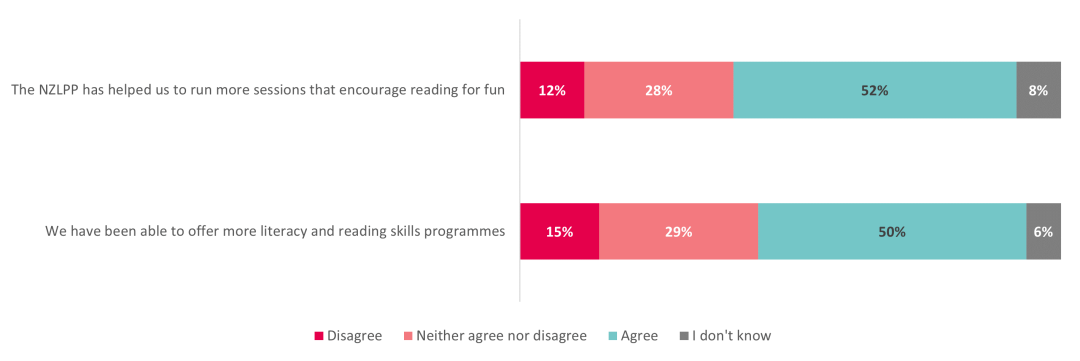
Source: Library Manager (n=42) and Secondee (n=67) evaluation surveys
Stacked bar graph showing survey respondents' responses as to whether they agree with the following statements:
12% — Disagree
28% — Neither agree nor disagree
52% — Agree
8% — I don't know
15% — Disagree
29% — Neither agree nor disagree
50% — Agree
8% — I don't know
50% (n=54)of survey respondents agreed that their library had been able to offer more literacy and reading skills programmes to their communities. These included:
liaising with other local organisations (such as REAP and adult literacy providers) to minimise the duplication of services
running socially-inclusive “queer book clubs” for youth and adults
working with schools to help build students’ relationships with the library and with reading
“Wriggle and Rhyme” reading classes for babies and parents
offering book delivery services to isolated residents
running reading classes for people with poor English language skills.
Through the NZLPP, libraries were encouraged and supported to increase their focus and inclusion of te reo Māori and mātauranga Māori. 11% of action statements were aligned to this focus area. As key repositories of knowledge and information, libraries have a unique role to play in promoting and normalising the use of te reo Māori, and to incorporate and display mātauranga Māori in their facilities.
Many library managers took advantage of the Secondee Project to recruit staff with specialist backgrounds in this area, including Cultural Services Librarians, Cultural Advisors, Cultural Programme Coordinators, and Māori Capability Advisors.
“It has changed the culture of our team. It has raised the bar for what the team expects from themselves, and what they think the community deserves (tikanga Māori as part of our standard meeting protocol, honouring the principles of the Treaty, and even just thinking about diversity at all in our planning). That has definitely changed our culture”
– Library manager, West Coast
Overall, 46% (n=50) of survey respondents agreed that, through the NZLPP, their libraries have increased the inclusion and support of te reo Māori and mātauranga Māori in their libraries. However, almost a quarter of respondents (22%,n=24) disagreed.
Figure 9: Te reo and mātauranga Māori outcomes achieved through the NZLPP
Source: Library Manager (n=42) and Secondee (n=67) evaluation surveys

Source: Library Manager (n=42) and Secondee (n=67) evaluation surveys
Stacked bar graph showing survey respondents' responses as to whether they agree with the following statements:
22% — Disagree
25% — Neither agree nor disagree
46% — Agree
7% — I don't know
32% — Disagree
30% — Neither agree nor disagree
33% — Agree
5% — I don't know
Feedback from across the sector has emphasised that library staff are highly passionate about giving mātauranga Māori greater emphasis in their work, and in supporting the use and revitalisation of te reo Māori. Many libraries have taken to incorporating karakia into their team meetings, as a way of incorporating more te ao Māori into their daily work. Other examples of ways in which libraries have been increasing their emphasis on te reo and mātauranga Māori include:
increased incorporation of local iwi histories into library displays
offering te reo Māori classes to staff
liaising with mana whenua to install bilingual signage in libraries
increased effort to engage and build relationships with iwi
increased engagement with kura
running events to celebrate Matariki, including flax weaving, te reo Māori classes, and local histories
facilitating te reo Māori classes for the community.
“Another one we have seen to varying degrees is an opportunity for libraries to step up and improve their relationships with local iwi groups. We have taken it as a chance to remove barriers to access, be more responsive to what is in their [iwi] local collections, and how we can help to showcase local Māori history and recorded knowledge. This should of course have been a priority before, but the additional funding has helped libraries to put resource and time to this” – Library manager, Nelson
However, while there is a high level of interest and passion in the sector, many stakeholders feel that it will not be possible to maintain these outcomes following the completion of the Programme. Some of the benefits that have been achieved are fixed and can be maintained (such as bilingual signage in libraries) but the ability to run te reo Māori classes, and continuing to build relationships with iwi, may not be able to be maintained following the departure of specialist secondees from the sector.
“We will of course continue to do our best, but without that knowledge and skillset it will be much harder and slower” – Library manager, Auckland
8% of action statements were related to content creation, which had a particular focus on the creation and curation of local resources and knowledge. The majority of survey respondents (70%, n=76) agreed that their library had managed to create more locally-focused content and resources, through the NZLPP.
Figure 10: Content creation outcomes achieved through the NZLPP
Source: Library Manager (n=42) and Secondee (n=67) evaluation surveys
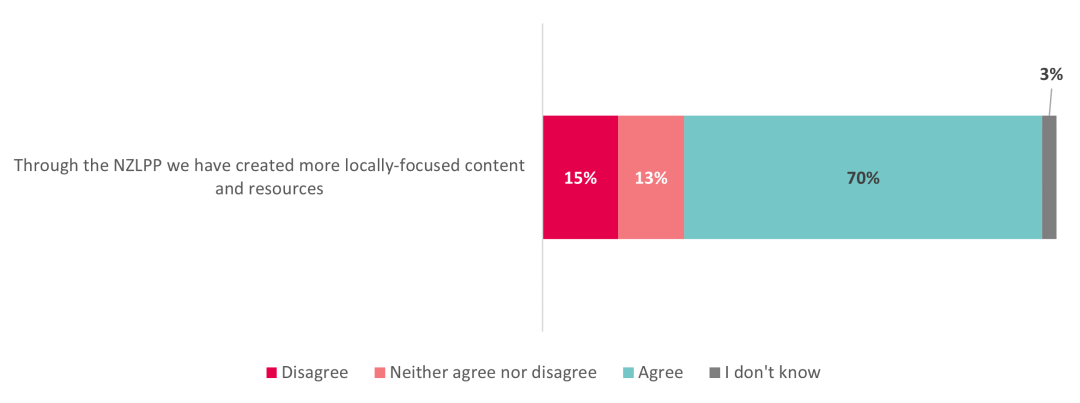
Source: Library Manager (n=42) and Secondee (n=67) evaluation surveys
Stacked bar graph showing survey respondents' responses as to whether they agree with the following statement
15% — Disagree
13% — Neither agree nor disagree
70% — Agree
3% — I don't know
The main focus of content creation was the digitisation of local knowledge and histories. Through the NZLPP, libraries hired Oral History Specialists, Local History Librarians, Heritage Digitisation Specialists, and Community Heritage Coordinators, to help build and preserve local historical content. This included conducting interviews with kaumātua, to preserve and share local iwi histories, and with elderly residents to record their life experiences and living in the area. Secondees digitised physical copies of historic documents, books and records. The digitisation of this information and knowledge not only helps to preserve the material, it also increases access to the resources by allowing people to access the archives and databases from anywhere in the world.
“I hope that we have been able to demonstrate to our council that the content we were able to provide as a result of the NZLPP is of great benefit to our community”
– Secondee, Otago
The digitisation of artefacts and the recording of local histories was the only major example of content creation shared by stakeholders. However, the content that has been digitised is likely to be among the most sustainable benefits from the NZLPP: with the content now archived, it will last far longer than the conclusion of the Programme and have an ongoing benefit for a wide range of users.
“Our digitisation work has been a very real benefit for the community, and will be an ongoing benefit”
– Library manager, Waikato
Survey respondents were asked for feedback about the impact of the NZLPP on Māori library users. Respondents were given the outcomes-focused questions described above, but asked to respond with a specific focus on the benefits generated for Māori users.
Overall, 46% (n=50) of respondents agreed that their Māori communities had been able to access more library resources digitally. 46% (n=50) also agreed that, through the NZLPP, their library had been able to do more to engage with their Māori communities.
However, across the other outcome areas there is a high degree of uncertainty about the benefit the NZLPP has had for Māori users. In the other nine outcome areas, between 40% and 50% of respondents were either neutral in their responses or did not know whether there had been any benefit for Māori library users (Figure 11).
The lack of clarity around the benefit of libraries and the NZLPP for Māori indicates that engagement with Māori may not be a specific focus for many libraries. This is a major gap that may best be addressed at a system-level rather than by individual libraries: engaging with Te Tiriti partners to identify how libraries can best support and engage with Māori communities, and establish a system of monitoring engagement and the benefits being provided to Māori users.
Figure 11: Benefit of the NZLPP for Māori users
Source: Library Manager (n=42) and Secondee (n=67) evaluation surveys
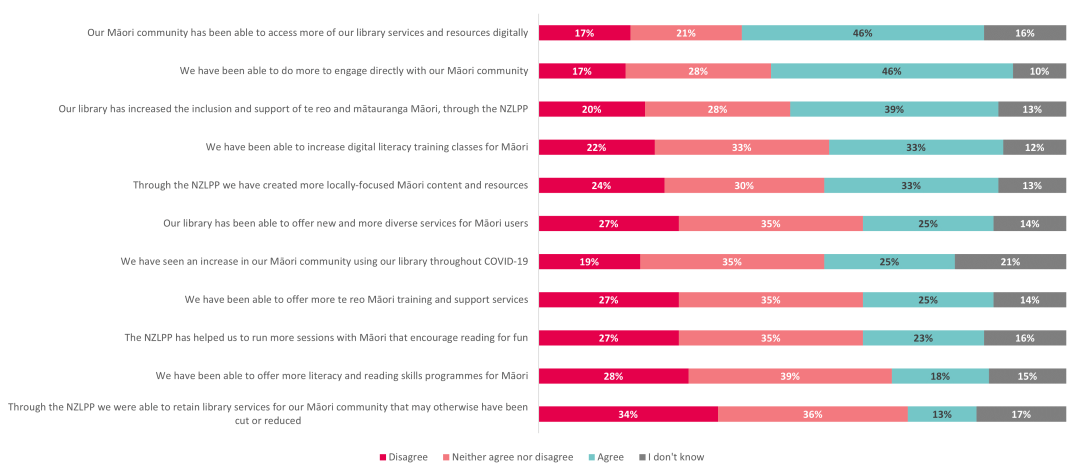
Source: Library Manager (n=42) and Secondee (n=67) evaluation surveys
Stacked bar graph showing Māori library users' responses as to whether or not they agree with various statements:
17% — Disagree
21% — Neither agree nor disagree
46% — Agree
16% — I don't know
17% — Disagree
28% — Neither agree nor disagree
46% — Agree
10% — I don't know
20% — Disagree
28% — Neither agree nor disagree
39% — Agree
13% — I don't know
22% — Disagree
33% — Neither agree nor disagree
33% — Agree
12% — I don't know
24% — Disagree
30% — Neither agree nor disagree
33% — Agree
13% — I don't know
27% — Disagree
35% — Neither agree nor disagree
25% — Agree
14% — I don't know
19% — Disagree
35% — Neither agree nor disagree
25% — Agree
21% — I don't know
27% — Disagree
35% — Neither agree nor disagree
25% — Agree
14% — I don't know
27% — Disagree
35% — Neither agree nor disagree
23% — Agree
16% — I don't know
28% — Disagree
39% — Neither agree nor disagree
18% — Agree
15% — I don't know
34% — Disagree
36% — Neither agree nor disagree
13% — Agree
17% — I don't know
“The best little library in New Zealand”
In Feilding, the library has a vision of being the ‘best little library in New Zealand’. Funding from the NZLPP has allowed the library to do more for the community, driving new initiatives forward without losing momentum in existing projects. The library staff are full of ideas, and talented at delivering activities, events and services for the community. These include social knitting classes, book clubs, Murder Mystery events, quiz nights, the Harry Potter family day, science and technology activities, and having time for a Justice of the Peace to be in the library.
One of the secondees has been focused on making sure the library works as a space for young people who have few places outside of their home and school to go and socialise. She has helped the young people to make a corner of the library their own, adding table tennis, being there to chat when they come to hang out, and adding a whiteboard for them to share their ideas for events and activities they would like to see. Although COVID-19 gathering restrictions have limited making many of these activities possible, as restrictions ease the library will have a mountain of ideas for engaging young people and encouraging them to use the library.
“Our library is a reflection of our community. It is a hub, with lots of services in one place, that people can use – it’s a no-judgement place”
Through the NZLPP, Feilding Library wanted to investigate the digital literacy needs of the community, and to provide opportunities for people to learn and upskill. In order to not reinvent the wheel, the library – through its Digital Programme secondee – engaged with other local organisations to understand the services that were already being offered to increase digital literacy.
“There was a lot of 1:1 help being offered” said the secondee, “so we decided to run some group classes”. The classes started off being well-attended, but numbers dropped over time. “People were commenting that the classes weren’t meeting their specific needs – it became clear that ‘basic computing’ meant a thousand different things to different people”. The library began to offer 1:1 support to complement the group classes, which met the diverse needs of users and also allowed them to reach different audiences. “We noticed that the classes were mainly female, and the 1:1 help was mostly male, so offering both has meant we could help more people”.
The digital upskilling has covered a range of different areas, from familiarising users with computer systems to accessing internet banking and helping to set up new smartphones. The digital upskilling services have also been used by people who had been made redundant during COVID-19, and needed to learn computing skills in order to get new jobs.
“I didn’t really know anything about computers” said one patron, “and with the bank making changes I had to learn about internet banking. I was told that the library could help. It has been fantastic help – he [the secondee] has helped me set up the banking, and now he’s showing me how to use video calling”.
“He has started me off easy, I had no real knowledge” said another patron. “My wife has lost her memory, and she did all of our finances. It was all on the computer, so I had to learn. He has been really patient with me. He even helped me set up my cell phone”.
Figure 12: 1:1 digital support for those needing a hand staying connected

Source: Facebook – Manawatū District Libraries, Fielding Library
“I don’t know what I would have done without the support – I wouldn’t have learned anything about computers”
Feilding Library seconded a Library Cultural Programme Coordinator to provide te reo Māori classes for the community and upskill library staff in te reo and tikanga. The library used the NZLPP to help normalise the use of te reo Māori in the library, provide opportunities for the community to engage with te reo, and integrate te reo and tikanga into existing library programmes.
“I think it is essential for Kiwi’s to learn te reo” said one patron who had been attending the language classes. “I can’t praise the course enough. He [the secondee] has made the library a warm and safe space to learn te reo without judgement. He has been so generous with his time and knowledge”.
The language classes are run twice a week, with up to 30 people in each. The programme started with one class, but became so popular a second class was added. The ākonga are learning the fundamentals of te reo Māori as well as developing a deeper understanding of the Manawatū region and its Māori history. The classes are attended by individual learners, as well as groups from the local medical centre and the intermediate school. In addition to running the language classes for the public, the secondee is also running sessions with the library staff to increase their understanding and use of te reo Māori and tikanga. He also works with local schools, teaching the students waiata and te reo, and helping them to prepare for their kapa haka festival.
“The ākonga are conduits to protecting the taonga that is te reo”
“My pronunciation of te reo was terrible,” said another patron. “When you are Pākehā, it can be a struggle. As a teacher, I had a real awareness of wanting to improve and pronounce place names correctly, not just for me but for my students. The great thing about him is he is so experienced, and he brings a lot of localised content into the classes”.
“The main highlight for me [of the NZLPP] has been running the te reo classes – watching people develop and learn,” said the secondee. “People at the library now always answer the phone with “Kia ora”, which they wouldn’t have done before. Some people can be hostile about it, but I’ve seen one of my students be staunch about reo and keep driving it forward in those moments. The ākonga are conduits to protecting the taonga that is te reo”.
“One of my proudest moments was having someone ask in te reo about a book, and I’m not fluent. But I could listen for the words I knew and help her without her having to switch to English once. That’s thanks to [our secondee]”
The development of the library workforce was a key focus area for the NZLPP, with 11% of action statements aligning to workforce development. The Programme gave non-library staff the opportunity to experience working in the library sector, while also giving library staff exposure to a range of different skillsets and areas of expertise.
The NZLPP was of considerable benefit to the library workforce. Stakeholders were asked to rate the level of benefit they felt the NZLPP had provided to the library workforce (with ‘1’ being very little or no benefit, and ‘5’ being a lot of benefit). As shown in Figure 13, 85% (n=93) thought it was of benefit to the library workforce.
Figure 13: Benefit of the NZLPP to the library workforce
Source: Library Manager (n=42) and Secondee (n=67) evaluation surveys
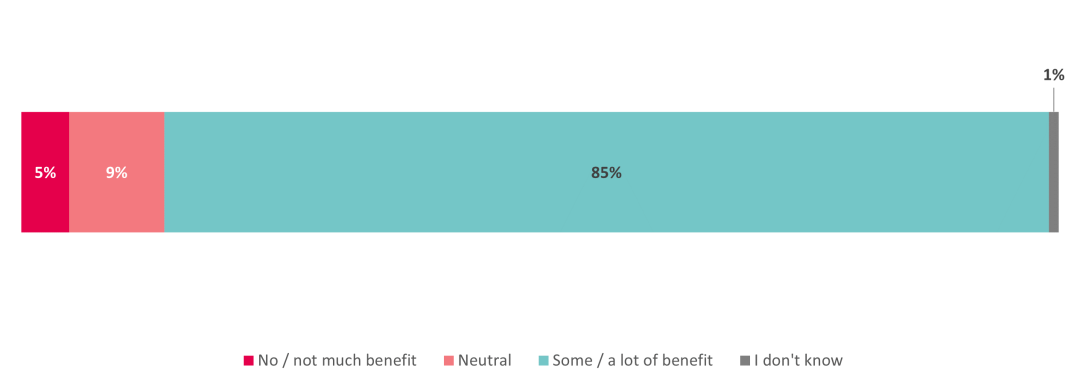
Source: Library Manager (n=42) and Secondee (n=67) evaluation surveys
Stacked bar graph showing stakeholders' ratings of the level of benefit they felt the NZLPP had provided to the library workforce.
5% — No / not much benefit
9% — Neutral
85% — Some / a lot of benefit
1% — I don't know
One of the main benefits of the NZLPP was the opportunity to give library staff exposure to technical skills and experience they may not otherwise have received. The secondees brought a wide range of new skills and perspectives to the library sector, including community engagement, digital literacy training, Māori engagement, event planning, te reo Māori, youth engagement, and project management. By working alongside the secondees the library workforce has gained exposure to new and more diverse skills, that they will retain beyond the conclusion of the Programme. Overall, 90% (n=38)of library managers agreed that they have seen an increase in the types of skills and experience of their staff, as a result of the NZLPP.
“Our staff really feel involved in the community because of the digital training courses, outreach activities, events and meetings the library now hosts or runs. With the NZLPP positions made permanent now, this involvement will be continued”
– Library manager, Canterbury
Figure 14: Workforce skill and experience outcomes achieved through the NZLPP
Source: Library Manager evaluation survey (n=42)
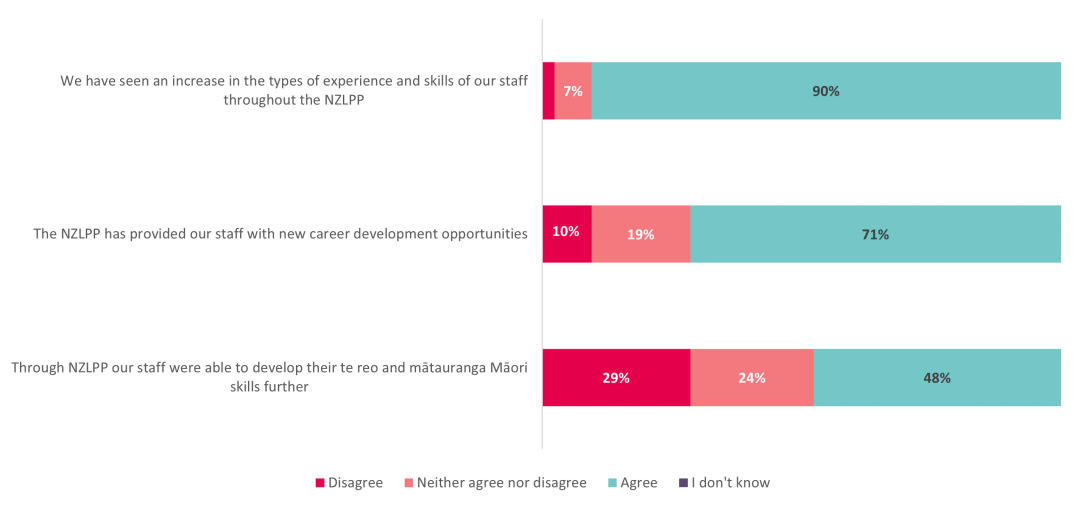
Source: Library Manager evaluation survey (n=42)
Stacked bar graph showing library managers' responses as to whether they agree with various statements:
3% — Disagree
7% — Neither agree nor disagree
90% — Agree
0% — I don't know
10% — Disagree
19% — Neither agree nor disagree
71% — Agree
0% — I don't know
29% — Disagree
24% — Neither agree nor disagree
48% — Agree
0% — I don't know
71% (n=30) of library managers agreed that the NZLPP had given their staff new opportunities to further develop their library careers. Through the NZLPP, library staff were able to work alongside secondees in areas that they would not traditionally have experienced in the library sector, learning new skills and further developing in their careers. The secondees provided some staff with the opportunity to develop their management skills, by supporting library managers with their increased workload by helping to coordinate and manage the secondees. The workforce also benefited from secondees taking on some of the more administratively-focused tasks in libraries, which freed staff time to work on more specialist and technical library projects.
“Some of our secondees were existing front-line customer service staff who had not been able to progress career-wise, due to lack of opportunities / lack of vacant roles to move into. It has been great to see them develop and be supported to practice some more advanced skills, like project management and community engagement skills”
– Library manager, Wellington
The opportunity to provide staff the chance to develop their te reo Māori skills and improve their understanding of mātauranga Māori was a key area of workforce development for the NZLPP. This was primarily facilitated through secondees who specialised in te reo Māori, but was also made possible by libraries choosing to send their staff on external te reo Māori training courses as part of their professional development. Overall, 48% (n=20) of library managers agreed that their staff had been able to further develop their te reo and mātauranga Māori skills through the NZLPP. 29% (n=12) of managers disagreed: this is likely from libraries that were not able to secure a secondee who specialised in this area.
“Through secondee positions we have gained new knowledge and a much-needed cultural perspective – a Māori liaison role which has been lacking for a long time. This person has helped staff a lot with te reo and any cultural questions”
– Secondee, SouthlandWe enabled staff to do their first te reo Māori lesson – we all did 10 weeks – and many have gone on to do their level 2 and 3 training”
– Library manager, Marlborough
The NZLPP sought to increase the diversity of the library sector. This was to be done not only through introducing the library workforce to new and varied skills and offering fresh experiences, but also through increasing the diversity of the library workforce itself.
“We knew that diversity was lacking. When you see yourself in a space, it makes you feel more comfortable using it. We had a young Chinese staff member years ago, and we saw what effect it had on the Chinese community using the library. We have seen the same with our Māori and Pasifika secondees”
– Library manager, Northland
Libraries have experienced an increase in the age diversity of staff through the NZLPP, with more younger staff being attracted to the sector. The library sector has an ageing workforce and has traditionally faced challenges in attracting new, younger people to take up careers in the sector. The NZLPP and the Secondee Project has provided a major opportunity for the sector to give experience to non-library workers and showcase libraries as a unique and interesting career opportunity. Stakeholders have reported that being able to attract younger people to the sector, even temporarily, has been highly beneficial in exposing them to a potential future career in the library sector. 57% (n=24) of library managers reported that they were able to attract younger people to the library sector, through the NZLPP.
“Some of the secondees that were new to the library sector have moved into permanent roles – it is great to retain new talent from diverse backgrounds. Some of them said they never saw the library as a place they could have a fulfilling career, before becoming secondees”
– Library manager, Wellington
Figure 15: Workforce diversity outcomes achieved through the NZLPP
Source: Library Manager evaluation survey (n=42)
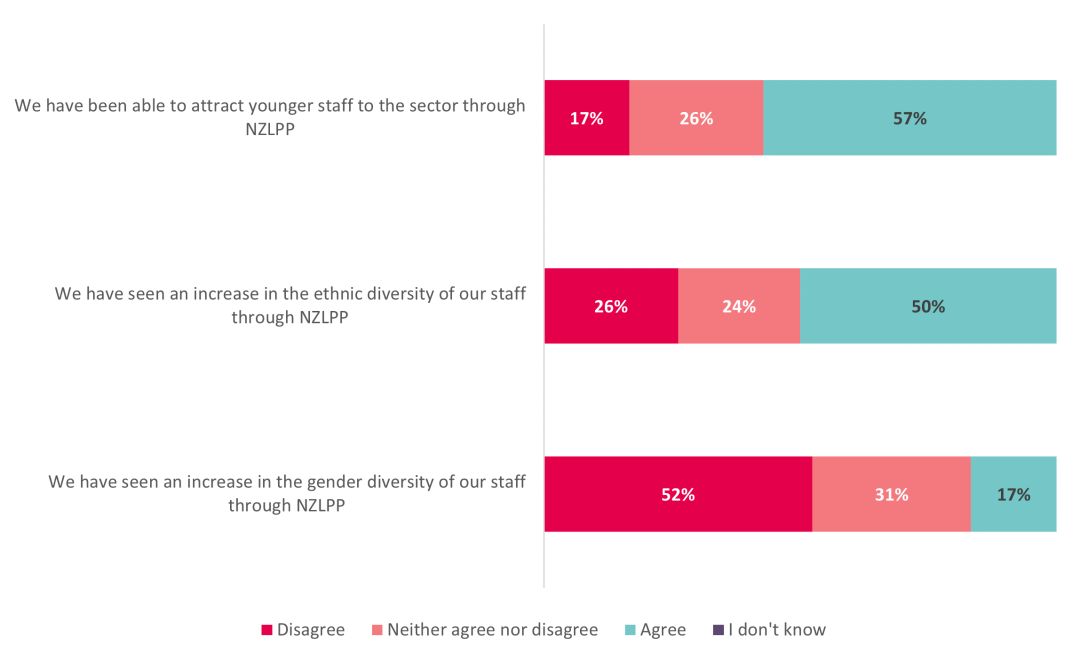
Source: Library Manager evaluation survey (n=42)
Stacked bar graph showing library managers responses as to whether or not they agree with various statements:
17% — Disagree
26% — Neither agree nor disagree
57% — Agree
0% — I don't know
26% — Disagree
24% — Neither agree nor disagree
50% — Agree
0% — I don't know
52% — Disagree
31% — Neither agree nor disagree
17% — Agree
0% — I don't know
There has also been an increase in the ethnic diversity of the workforce throughout the NZLPP. With the library workforce being predominantly European, the NZLPP provided an opportunity to attract people from a greater diversity of ethnicities to experience what it is like to work in the library sector.
“The Secondee Project meant we could have Māori and Pasifika staff focusing on those communities for the first time. This is something we have wanted for a decade but could never get it over the line”
– Library manager, Taranaki
50% (n=21) of library mangers reported that they had seen an increase in the ethnic diversity of their staff. Feedback from the sector indicates that the majority of this increase has been staff of Māori and Pasifika descent.
“Our Māori engagement secondee has played a massive role in the community – running workshops for our elderly Māori residents, building relationships with local iwi. She has gone on to a permanent role with the National Library, so her skills and knowledge are staying in the sector”
– Library manager, Hawke’s Bay
Although the sector has seen an improvement in the age and ethnic diversity of the workforce, and diversity in skills, backgrounds and experience, there has not been a similar increase in gender diversity.
The library sector is by and large a female-dominated industry, with approximately 85% of library managers being female. Although the NZLPP did succeed in attracting males to the sector, by way of the Secondee Project, male secondees only accounted for approximately 12% of the secondees that were recruited.
“A key issue is gender diversity. That is a challenge across the sector, for all libraries full stop. We had one male in our team of 27 before the NZLPP. Now we have three”
– Library manager, Waikato
Only 17% (n=7) of library managers agreed that there had been an increase in the gender diversity of staff through the NZLPP. The majority of respondents (52%, n=22) disagreed that there had been any change.
One of the main areas of focus for Hurunui District Libraries was increasing the engagement of the community in the library. Community engagement presents a unique challenge in Hurunui, as there are nine libraries spread across the district – some of which are staffed entirely by volunteers.
“The opportunity to bring in extra staff has been an absolute godsend” said one of the managers. “We have been able to get out and do things that we have always wanted but never been able to do. Our staff, and the secondees, they don’t just do their job – they go above and beyond”.
The additional funding and staff capacity provided by the NZLPP has had an “amazing” impact on the community, said one of the library volunteers. “The secondees have been absolute stars. They have come in with enthusiasm and brought fresh ideas and skills to the library. They have helped bring kids and young adults into the library, too. They are a real asset”.
Through the NZLPP, Hurunui District Libraries were able to deliver a range of activities to increase community engagement, including:
quiz nights
Lego club
school holiday programmes and activity packs
craft and knitting classes
children’s story-time
afterschool programmes
click and collect services
book delivery services
digital upskilling classes and device support
“Having the extra capacity has meant that we have been able to do so much more for people across the District”
At the beginning of the NZLPP, the Hurunui District Libraries team were eager to take advantage of the opportunity to attract new staff to the sector and develop their library skills. “I think a lot of people, especially Councils, think that just anyone can work at a library” said one of the volunteers. “We wanted to try to change that mindset and make people see that there is skill and expertise involved”.
“Right from the start the main thing we wanted to do was to introduce non-library people to what it is like to work in a library,” said one of the managers, “and we did well – the secondees came in fresh-faced and quickly embraced the skills needed to work in a library”.
There was no shortage of interest in working for the library: Hurunui ultimately selected three secondees from dozens of applications. “Our library was already under-resourced,” said one of the managers, “so the NZLPP helped to get us up to a good level of service”. The addition of extra resourcing has enabled Hurunui to deliver more services and programmes to the community than before, and has given the secondees exposure to a wide range of new skills.
Having secondees who were new to the library sector also presented challenges. “We would have benefited from more direction from the NZLPP team around the activities or projects that we could have run” said the secondees. “We had to rely on the managers to suggest projects, which wasn’t necessarily the best way to go about it – not every manager across the country has a strategic mindset”.
There were also concerns about what impact the end of the NZLPP would have on the library. “My main concern was ‘at the end of the Programme, what happens’? How will the community react if we have to pull back services once the Programme finishes?” said one of the managers. However, due to the resignations of some of their permanent staff, Hurunui District Libraries have been able to retain two of their three secondees. “Although we have gone back to the same number of staff as before the NZLPP, we have been able to retain passionate staff that have learned what it means to work in a library and who have excelled” said one of the managers.
“Being a secondee in the library has been great. And now I am going on to do my Diploma in Library and Information Studies, to carry on with my career in the library”
Another objective of Hurunui District Libraries was to work with local historical societies to digitise their material and increase the online accessibility of their collections.
“The library is letting me help at the Cheviot Museum one day a week” said one of the secondees. “I’ve been helping to catalogue their archives and summarising it all on the computer system. I’ve also reorganised the cataloguing system”.
“She has been an absolute delight” said the museum manager. “It was so good of the library to share her time with us”.
“She has been going through our collection, item by item, and cataloguing them – taking photos of every item and adding them to the database, recording the history – when and where it was from, and who donated it – and writing a biography about the item. She has recorded more than 500 items. We would be so far behind without her”.
“The great thing about me doing this archiving work is, once it’s done, it’s done. It is in the system for other to access, so it is a long-lasting benefit”
Figure 16: A sample of the catalogued collection at Cheviot Museum
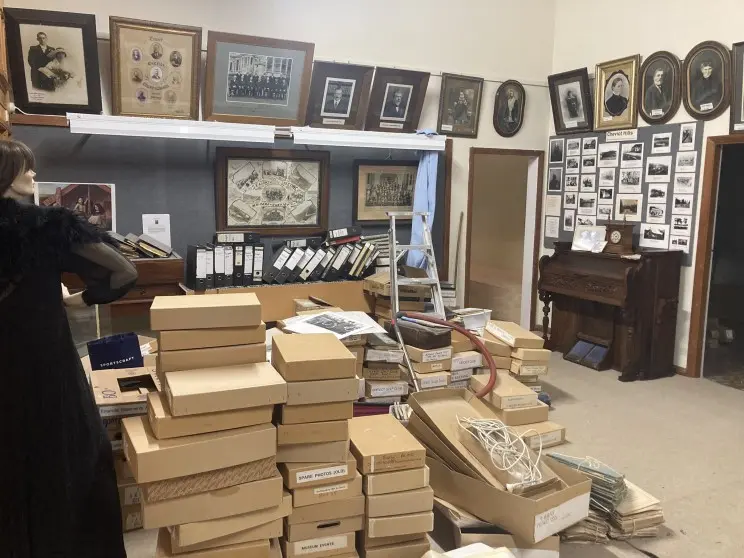
Source: MartinJenkins evaluation team
“Our library was able to offer a permanent, fulltime contract to its secondees moving forward which was fantastic. Without the extension of the roles the new offerings of the library would be hard to sustain due to staffing constraints” – Secondee, Canterbury
Although the Programme has achieved considerable benefit and outcomes for communities across Aotearoa New Zealand, there are concerns about whether these benefits will be sustainable beyond the end of the NZLPP.
Most of the benefits over the past two years have been enabled through added resources (the Secondee Project) and added funding (the Fee Waivers). With the NZLPP ending on 30 June 2022, many stakeholders do not think it will be possible to continue offering the same services to the community, with many libraries reporting that they will likely return to a pre-NZLPP level of service.
“The secondees have done amazing work, but there is unfinished work being left on the shoulders of already overworked staff. The progress and the outcomes aren’t sustainable”
– Library manager, Wellington
Similar to the benefit rating above, survey respondents were asked to rate the sustainability of the benefits generated by the NZLPP (with ‘1’ being not at all or not very sustainable, and ‘5’ being very sustainable). 28% (n=31) of respondents (Figure 17) do not feel the benefits produced for library users are sustainable; 32% (n=35)do not feel the benefits for the library workforce are sustainable.
Figure 17: Sustainability of the benefits produced through the NZLPP
Source: Library Manager (n=42) and Secondee (n=67) evaluation surveys
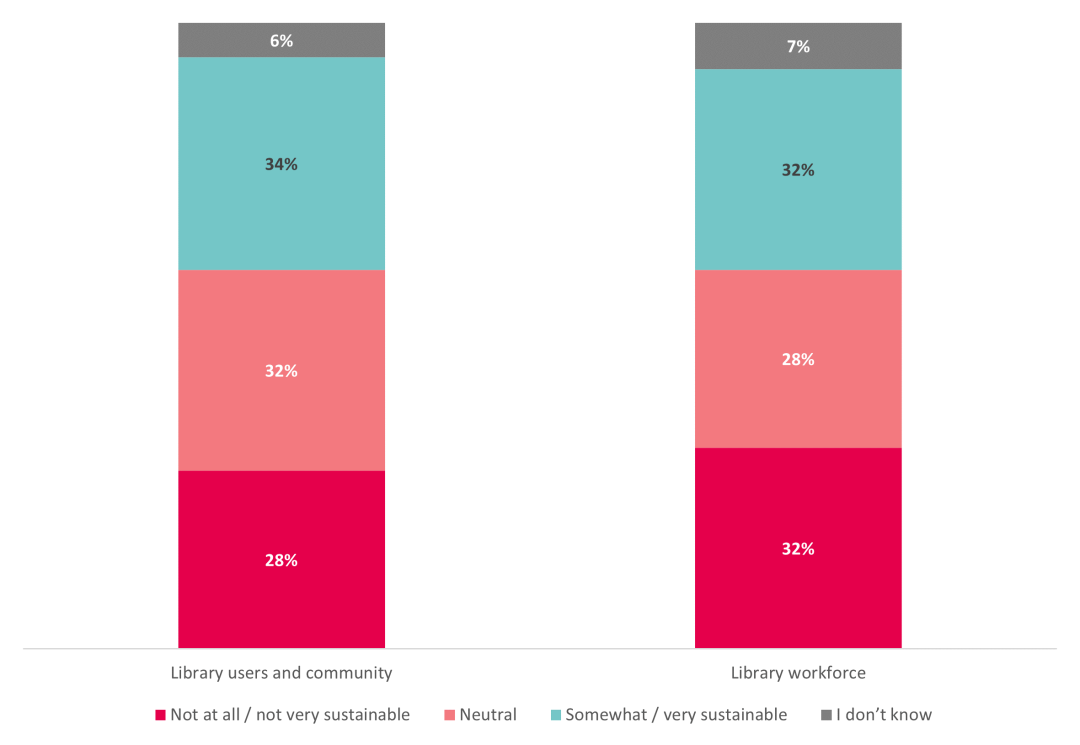
Source: Library Manager (n=42) and Secondee (n=67) evaluation surveys
Stacked bar graph showing survey respondents opinions of the sustainability of the benefits generated by the NZLPP.
28% — Not at all / not very sustainable
32% — Neutral
34% — Somewhat / very sustainable
6% — I don't know
32% — Not at all / not very sustainable
28% — Neutral
32% — Somewhat / very sustainable
7% — I don't know
The concerns about the sustainability of the benefits are:
a lack of staff to continue or complete projects
a loss of connections and relationships held by the secondees
a lack of additional funding to continue to deliver the new services
specialist skills and experience leaving the library sector
a general decrease in staff numbers, making it difficult to maintain the level of service made possible through the NZLPP.
However, one-third of survey respondents felt that the benefits generated through the NZLPP are in fact sustainable.
“The NZLPP has given us a blueprint for future growth – giving us new ideas and helping us to think differently”
– Secondee, Canterbury
The library sector, through the NZLPP, has delivered a significant number of projects and initiatives, and achieved a range of positive outcomes for their communities. The benefit of the Programme has been considerable, and library managers and staff are not willing to lose the gains they have made or see the positive changes in their communities undone.
“The secondees brought knowledge and skills to the team that was previously lacking. They were able to significantly improve the breadth of programmes we offered to the community – some of which we can continue, others will continue in some form in the community”
– Library manager, Auckland
Although many of the secondees will move on from the library sector, they have taught library staff valuable knowledge and skills that they can continue to apply in their day-to-day jobs – such as community engagement, project management, digital literacy, and event planning. Stakeholders have reported that their libraries intend to ‘think differently’ – reflect on their traditional service offerings and identify what should continue, and what could make way for the new services and initiatives delivered under the NZLPP. With ongoing demand for the programmes delivered under the NZLPP, libraries are mindful that there is an expectation in their communities for a certain level of service, and are continuing to work with their Councils to secure the funding and resourcing required to meet the community demand.
“We have an expectation now to continue to provide more engagement and outreach within our community - with many of our staff wishing to continue this”
– Library manager, Canterbury
Despite concerns that the NZLPP’s benefits may not be sustainable, there are indications that the sector has been strengthened and will manage to retain many of the secondees.
More than half of library managers (60%,n=25)said they will be able to retain secondees beyond the end of the NZLPP. Many managers were able to use the success of the Programme to convince their council to let them retain the additional staff, in a mixture of full-time, part-time, and temporary roles (3). In some cases where the secondee had already left, managers have been authorised to recruit to fill the roles, thanks to the benefits created for the community by the secondees while in those roles.
“The benefits are going to be sustainable because it’s a permanent role now. If we didn’t have it as permanent, we would lose benefits and existing staff wouldn’t have capacity to continue this work on top of business as usual”
– Library manager, Taranaki
Figure 18: Workforce retention outcomes achieved through the NZLPP
Source: Library Manager evaluation survey (n=42)
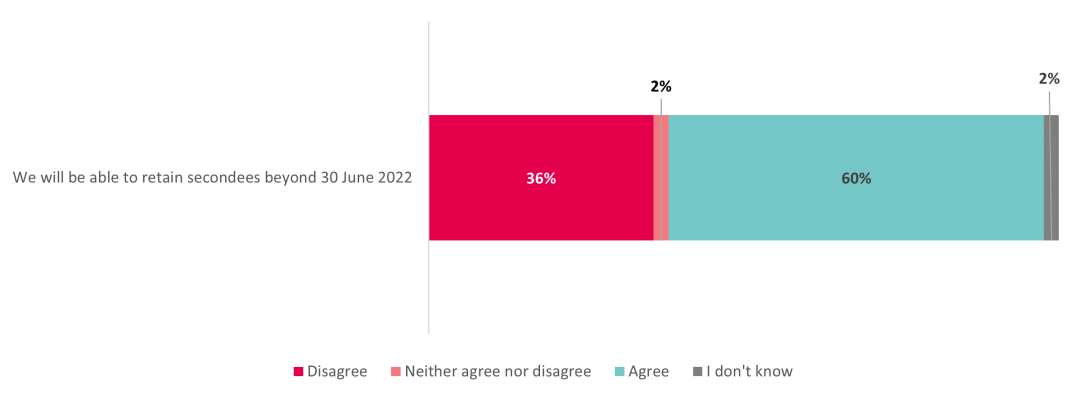
Source: Library Manager evaluation survey (n=42)
A clustered bar graph showing library managers' responses as to whether they will be able to retain secondees beyond the end of the NZLPP.
36% — Disagree
2% — Neither agree nor disagree
60% — Agree
2% — I don't know
The secondees were asked about their intentions to continue working in the library sector following the conclusion of the NZLPP. Two-thirds of respondents (67%,n=45) indicated they intend to remain in the library sector, with 15% (n=10) intending to leave, and 18% (n=12) unsure.
Figure 19: Secondee intentions to remain working in the library sector
Source: Secondee evaluation survey (n=67)
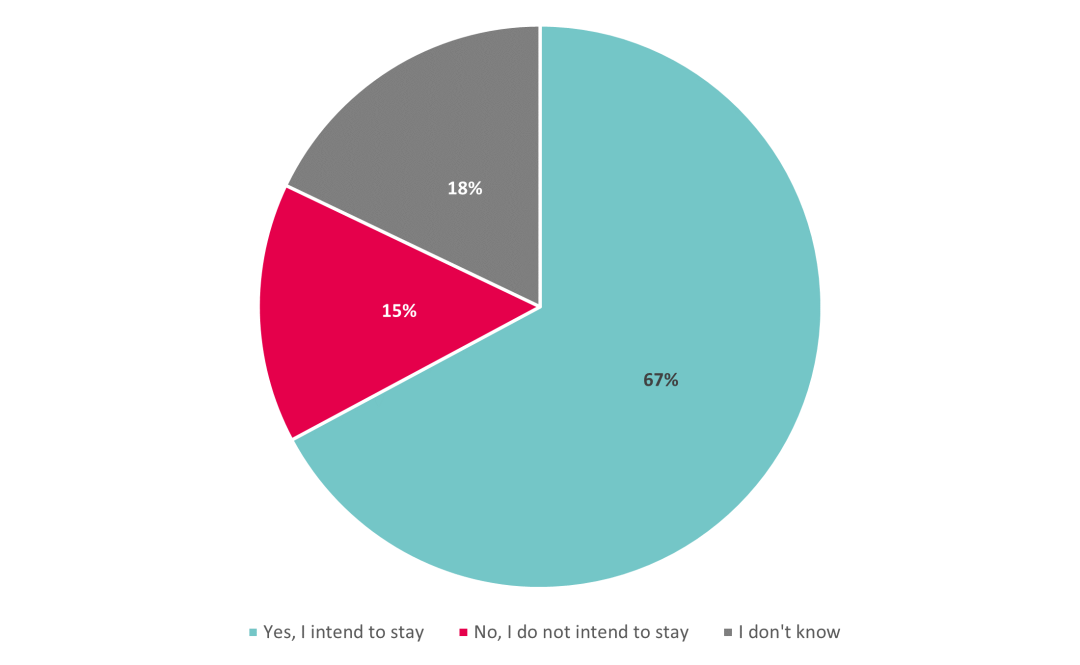
Source: Secondee evaluation survey (n=67)
Pie chart showing secondees intentions to continue working in the library sector following the conclusion of the NZLPP.
67% — Yes, I intend to stay
15% — No, I do not intend to stay
18% — I don't know
Figure 20 shows a comparison of the intention to stay in the sector between secondees who were already working for libraries prior to the NZLPP, and those who were recruited through the Programme. 75% (n=33) of those who were already working in the sector intend to remain working for libraries; only 7% (n=3) do not intend to stay. While fewer of the NZLPP external recruits intend to remain in the sector, 50% (n=11) still intend to remain working for libraries; 32% (n=7) of these secondees do not intend to remain working in the sector.
Figure 20: Comparison of secondee intentions to remain working in the library sector
Source: Secondee evaluation survey (n=67)
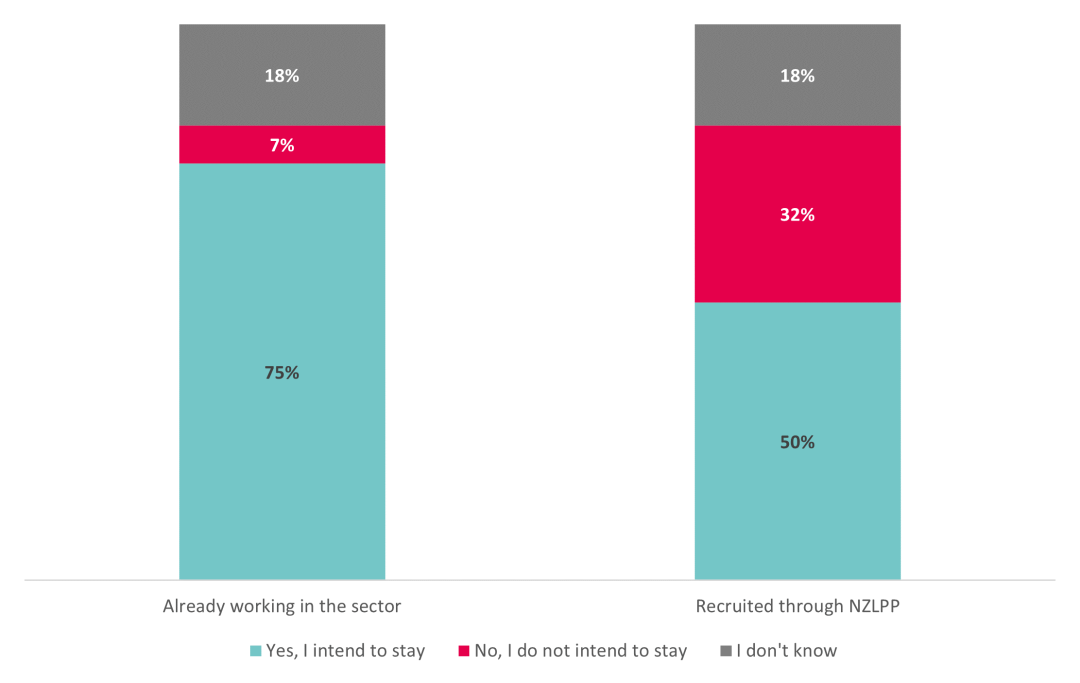
Source: Secondee evaluation survey (n=67)
A stacked bar graph comparing intentions to stay in the library sector between those were already working in the sector and those who were recruited through NZLPP.
75% — Yes, I intend to stay
7% — No, I do not intend to stay
18% — I don't know
50% — Yes, I intend to stay
32% — No, I do not intend to stay
18% — I don't know
In March 2022, MartinJenkins developed a comprehensive plan for the evaluation of the NZLPP. The purpose of the evaluation was to determine what had been achieved through the Programme, and the impacts the Programme was having on the sector. The evaluation was focused on identifying short-term outcomes and impacts of the Programme, as it is too early to form a comprehensive assessment of the impact the NZLPP has had on the sector.
The evaluation plan was anchored in an intervention logic and a high-level theory of change. The theory of change (Figure 21) provides a high-level description of the key outcomes that were expected from the NZLPP funding, for both libraries and the communities they serve, as well as the impacts the funding was designed to achieve: sustainable libraries remaining at the heart of their communities and helping their communities to thrive.
Figure 21: Theory of change for the NZLPP

A diagram describing the theory of change for the NZLPP.
From top to bottom:
libraries provide free, accessible, and practical supports and services, specifically designed for diverse community needs during the pandemic, and delivered by a skilled, diverse workforce
communities, iwi and Māori will be supported to get through COVID-19; communities will benefit — improved digital literacy, learning, and connection; and the library workforce will be strengthened and invigorated
enable individuals and communities to thrive, and ensure libraries are sustainable, relevant, and at the centre of the community
The intervention logic (Figure 22) provides greater detail of how the funding was used, and the outputs and short-term outcomes that were expected. It also shows the medium- and long-term outcomes the NZLPP is expected to contribute to, and the ultimate impact that is expected.
Figure 22: Detailed intervention logic for the NZLPP
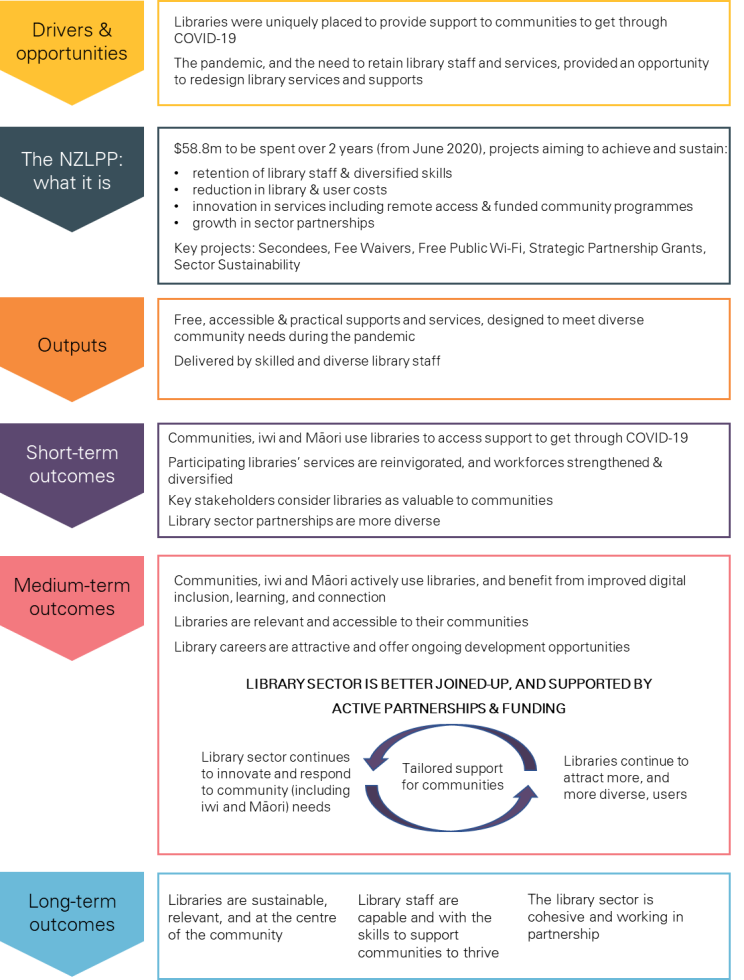
Diagram describing the intervention logic for the NZLPP.
From top to bottom:
Libraries were uniquely placed to provide support to communities to get through
COVID-19
The pandemic, and the need to retain library staff and services, provided an opportunity to redesign library services and supports
$58.8m to be spent over 2 years (from June 2020), projects aiming to achieve and sustain;
retention of library staff & diversified skills
reduction in library & user costs
innovation in services including remote access & funded community programmes
growth in sector partnerships
Key projects: Secondees, Fee Waivers, Free Public Wi-Fi, Strategic Partnership Grants, Sector Sustainability
Free, accessible & practical supports and services, designed to meet diverse community needs during the pandemic
Delivered by skilled and diverse library staff
Communities, iwi and Maori use libraries to access support to get through COVID-19
Participating libraries’ services are reinvigorated, and workforces strengthened & diversified
Key stakeholders consider libraries as valuable to communities
Library sector partnerships are more diverse
Communities, iwi and Maori actively use libraries, and benefit from improved digital inclusion, learning, and connection
Libraries are relevant and accessible to their communities
Library careers are attractive and offer ongoing development opportunities
Library sector continues to innovate and respond to community (including iwi and Māori) needs
Tailored support for communities
Libraries continue to attract more, and more diverse users
Libraries are sustainable, relevant, and at the centre of the community
Library staff are capable and with the skills to support communities to thrive
The library sector is cohesive and working in partnership
The focus of the evaluation was the outputs and short-term outcomes achieved by the NZLPP, primarily through the Programme’s three main initiatives: the Secondee Project, Free Public Internet, and the Fee Waiver. The evaluation considered the longer-term sustainability of these outcomes, but did not explicitly focus on the Sustainability Initiatives or the Strategic Partnership Grants.
The evaluation was designed to collect input from a broad range of stakeholders, to understand the impact of the NZLPP on the library sector. Through the mixed-methods design, a wide selection of voices have contributed to the evaluation.
The key inputs to the evaluation were:
interviews with library sector stakeholders
a survey of library managers and secondees
visits with libraries across Aotearoa New Zealand
We interviewed a total of 27 library managers, secondees, and NZLPP team members across New Zealand:
17 library managers
7 secondees
3 NZLPP team members
These semi-structured interviews focused on:
the design and implementation of the NZLPP
the support received by libraries from the NZLPP team
the outcomes achieved through the NZLPP
the support provided to vulnerable and marginalised communities
the impact of the NZLPP on the library workforce
the opportunities and challenges facing the library sector
The interviews were conducted between April and June 2022.
Survey links were sent to all library managers, and to secondees who were still active in the Programme. The surveys were identical, but the secondees were asked additional questions about their intentions to remain working in the library sector.
In total:
65 survey links were sent to library managers, with 42 completing their survey – a response rate of 65%
185 links were sent to secondees, with 67 completing their survey – a response rate of 36%
Overall, the surveys had a response rate of 44%.
The survey was co-designed by the NZLPP project team and MartinJenkins. It consisted of a combination of qualitative and quantitative questions, and was designed to capture broad and diverse feedback from a range of stakeholders across the library sector. The survey covered:
sector feedback on the Secondee Project, Fee Waiver, and Free Public Internet initiatives
outcomes achieved through the NZLPP (for the workforce, for Māori, and for the wider community)
the sustainability of the outcomes
The survey was live between 9 and 30 June 2022.
The evaluation team also visited three library locations across the country:
Whakatāne Library
Hurunui District Libraries
Feilding Library
These site visits were designed to help the evaluation team to generate deeper insights into the Programme, and to provide clear examples of the outcomes being achieved through the Programme.
We developed a short-list of potential sites using the following selection criteria:
a combination of semi-rural and small urban communities
medium-to-high levels of deprivation
libraries with a focus on te reo and mātauranga Māori
accessibility (locations that were not isolated)
libraries with multiple initiatives underway
libraries with active secondees.
The site visits were made between 20 and 28 June 2022.
The visits provided the evaluation team with the opportunity to experience first-hand the work that libraries had done as a result of the NZLPP. During the library visits, the evaluation team met with 38 people, including:
Library managers
Library staff
Secondees
Library volunteers
Community members.
The site visits were used to produce the three case studies included in this report.
In total, 152 individuals have informed this evaluation.
Figure 1: | Proportion of NZLPP action statements aligned with each focus area | 6 |
|---|---|---|
Figure 2: | Ranking of which initiative was of most benefit to libraries | 8 |
Figure 3: | Māori Women’s Welfare League ukulele group performing at Murupara Library | 16 |
Figure 4: | Benefit of the NZLPP to library users | 17 |
Figure 5: | Proportion of projects able to be completed without the NZLPP | 18 |
Figure 6: | Community engagement outcomes achieved through the NZLPP | 19 |
Figure 7: | Digital inclusion outcomes achieved through the NZLPP | 21 |
Figure 8: | Reading for pleasure outcomes achieved through the NZLPP | 23 |
Figure 9: | Te reo and mātauranga Māori outcomes achieved through the NZLPP | 24 |
Figure 10: | Content creation outcomes achieved through the NZLPP | 25 |
Figure 11: | Benefit of the NZLPP for Māori users | 27 |
Figure 12: | 1:1 digital support for those needing a hand staying connected | 29 |
Figure 13: | Benefit of the NZLPP to the library workforce | 32 |
Figure 14: | Workforce skill and experience outcomes achieved through the NZLPP | 33 |
Figure 15: | Workforce diversity outcomes achieved through the NZLPP | 35 |
Figure 16: | A sample of the catalogued collection at Cheviot Museum | 39 |
Figure 17: | Sustainability of the benefits produced through the NZLPP | 41 |
Figure 18: | Workforce retention outcomes achieved through the NZLPP | 43 |
Figure 19: | Secondee intentions to remain working in the library sector | 43 |
Figure 20: | Comparison of secondee intentions to remain working in the library sector | 44 |
Figure 21: | Theory of change for the NZLPP | 45 |
Figure 22: | Detailed intervention logic for the NZLPP | 46 |
The APNK “offers computer hardware and high-speed internet for New Zealand public libraries so that all New Zealanders can be connected online”: What APNK offers, , retrieved 24 Aug 2022. 2 Strategic Partnership Grants and Library Sector Sustainability are out of scope for this evaluation.3 Vacancies were also created by library staff resigning, many due to COVID-19 vaccination requirements.
Strategic Partnership Grants and Library Sector Sustainability are out of scope for this evaluation.
Vacancies were also created by library staff resigning, many due to COVID-19 vaccination requirements.